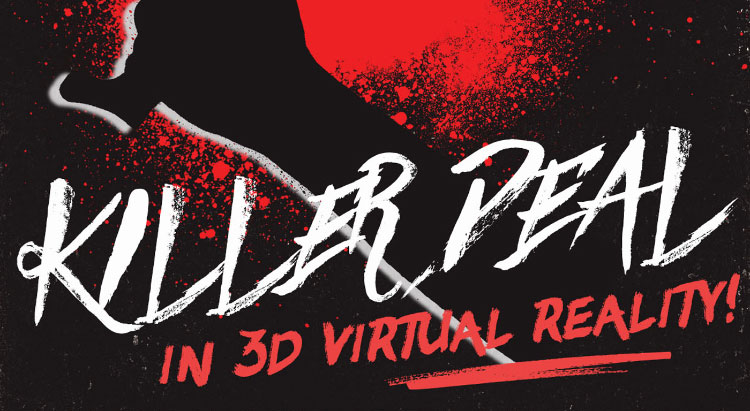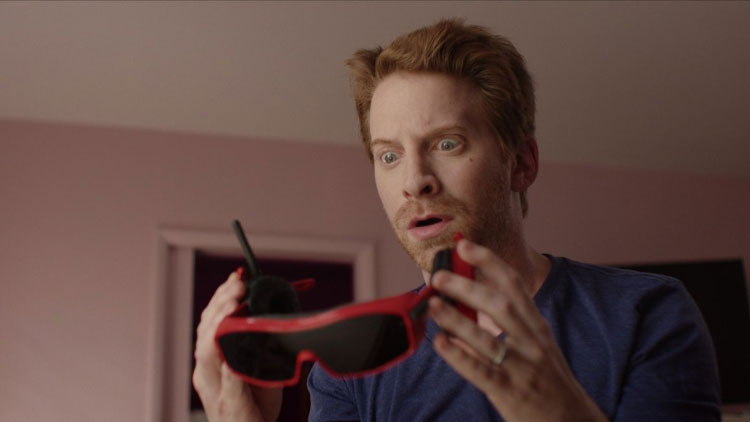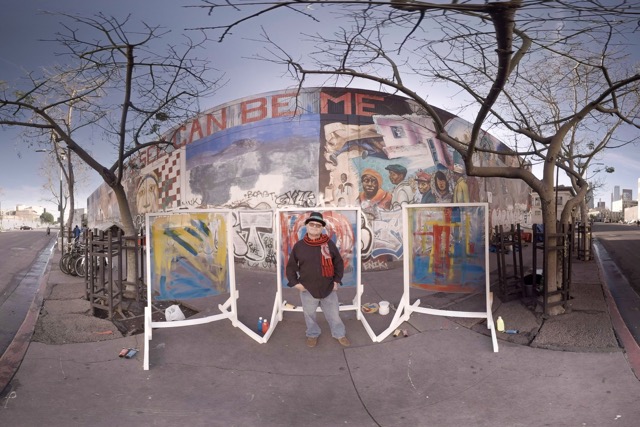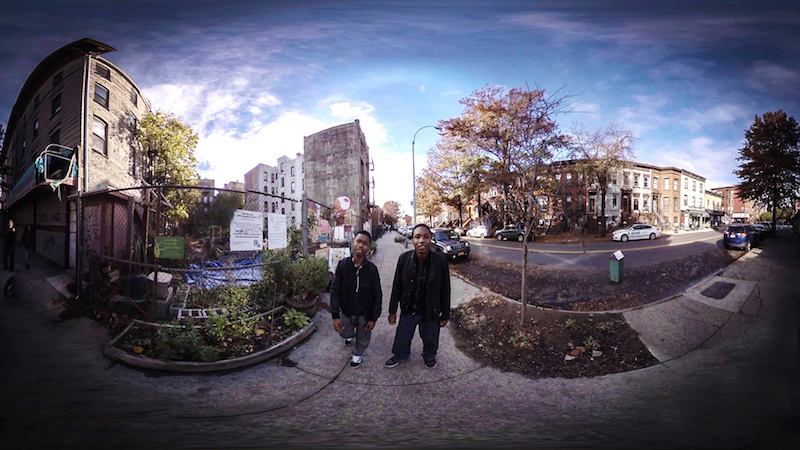As with Tribeca’s Storyscapes program, Virtual Arcade is meant to highlight the intersection of story and technology with an even stronger focus on VR. The films at the Virtual Arcade ratchet up both the interactivity and immersion by requiring you to move around a small enclosed booth usually holding controllers that track your body position and hand movements. Of course, that extra immersion comes at a cost of longer lines and a full-time technical chaperone.
Like smell-o-vision and other novelties that were once spurred on by the introduction of 3D films, today’s wave of enthusiasm for VR has kicked off an arms race once again to see just how real we can make these virtual experiences.
Dragonflight
Created by Blackthorn Media / HTC Vive
Made at the request of Tribeca, Dragonflight is a VR peek into a game of the same name. The objective is to ride a dragon and use the wands to shoot fireballs at everything you see. Interaction is a bit limited, and the best part of the experience happens in the first few moments when you climb onto the dragon’s back (you actually sit down in a chair). Needless to say there’s no real story here. It’s a game demo that’s probably more at home on the floor of GDC than a film festival. You can get your hands on a beta version of the full game via Steam.
The Crystal Reef
Cody Karutz & Lauren Knapp, Stanford University / HTC Vive
Another VR experience that would be difficult to describe as a film. The Crystal Reef: Interactive is part PSA and part video game from 1998. You use the Vive controllers to “swim” around a defined ocean area and collect specimens but the tracking and movement is more nauseating than graceful. Good message, but as an experience, it falls short of what a great VR swimming experience could be. There’s another piece for the same project that’s more of a standard VR film, but I didn’t try it.

Killer Deal
Created by Irad Eyal, Aaron Rothman, Anthony C. Ferrante, iMan Productions, Better VR Studios / Samsung Gear VR
I’m not a huge horror fan, but even I’ve been excited about the potential it has in VR. Killer Deal is a horror film directed by Anthony Ferrante (creator of the Sharknado franchise) staged like a theatrical play where you sit as an observer in a single environment (a dingy motel room). Inside, a machete salesman finds strange things lurking in his room. It’s a solid story with genuine scare moments that come right into your face (you can’t move your viewpoint), and uses the flickering lights to act as cuts to introduce moments of surprise. The spraying blood is a bit over the top (not unlike bad early 3D when things jumped directly out into the camera), but the film stands as a good representation of what VR can do to heighten your adrenaline.

Click Effect
Created by Sandy Smolan & James Nestor with Annapurna Pictures, Vrse, The New York Times, The Sundance Institute / Samsung Gear VR
I was excited about the premise of Click Effect—free diving with whales and dolphins to experience their foreign form of communication. But the execution doesn’t play out as well as it could. Shots transition too quickly to get lost in the individual scenes, and the lower-quality of the phone-based Samsung Gear compared to a dedicated headset doesn’t represent the scale and depth well when you can see noticeable color banding in the gradations of water and you lose the detail in these enormous creatures. Commissioned by New Frontier at Sundance Institute for The New York Times Op-Docs, and supported by Megan Ellison’s Annapurna Pictures (Her, American Hustle), you can experience it at home if you have a Google Cardboard by downloading either the Vrse or NYT VR apps, or you can watch the 360 video on desktop.
Artist of Skid Row
Created by Molly Swenson, Tyson Sadler, Hayley Pappas, RYOT / Samsung Gear
This is the latest from RYOT, the social awareness production company/content platform whom we have featured films from in the past, most notably the 2012 Tribeca-winner Baseball in the Time Cholera. RYOT has increasingly moved the focus of their work to 360, and are now on the forefront of reportorial-style VR, a transition that culminated in the company’s purchase last week by The Huffington Post. This film is more of a straight up profile doc and tells the story of a worthy subject, a formerly homeless LA man whom has found solace and redemption through art.
If you enjoy profile docs, it is a charming, though not particularly remarkable, entry. From the perspective of craft, the film is hurt by the poor latitude in exposure the GoPro rigs provide, and the post-production “stitching” was some of the most noticeable in any of the films we experienced. Ultimately, unlike some of RYOT’s disaster reporting, where the 360 really adds a huge dimension to the experience, there did not seem like much of a reason for this film to employ the newer tech.
Ashes
Created by Jessica Kantor, supported by Vrideo / Samsung Gear
An experimental dance piece, Ashes tells the story of doomed lovers through performance. The viewer is placed in a static spot on the beach, and viewers can observe 3 different performances from the couple by moving their head in different directions. In principle this is the kind of short performance piece that could do well on a site like Nowness, but to say that is to misunderstand the typical appeal of those films—here the camera is at quite a remove from the performers, killing the intimacy, and 360 camera technology is not yet adequate to the point of crafting truly beautiful images. This one ends up being an interesting misfire.
Hard World For Small Things
Created by Janicza Bravo, Wevr / Samsung Gear
WEVR (prounced “weaver”), has made an interesting name for themselves in this early age of VR film content by targeting bold filmmakers rather than simply technologists. Ms. Bravo is a Sundance Grand Prize winner (Gregory Go Boom), and is one of the most distinctive short filmmakers working currently. This experience is a slice of life LA story with a tragic end, and while a lot is messy, it is also one of the most exciting we saw at Tribeca.
As we tag along with a group of 3 out for a drive, we pull up to a convenience store. The 3 characters split up for a bit as new characters enter the scene, and the result is beautifully chaotic – 3 separate conversations all overlapping, and moved up and down in the mix via your attention. The film is one of the few we saw to employ a hard cut (some say that is a no-no, but I disagree), however I did miss the climactic action because I was looking in the wrong direction. Overall a strong entry that points to some interesting ways forward for storytelling in the medium.
Perspective 2: The Misdemeanor
Creators Rose Troche, Morris May, Collaborators: Amy Lo, Charles Ottoway / Samsung Gear
Much of the early literature on VR and VR filmmaking focuses on the “empathy” that immersive 1st person perspectives can lend to viewers. Rose Troche is determined to test that hypothesis with her Perspectives series. The second entry, following Sundance 2015’s famous “rape simulator”, The Misdemeanor is about an urban tragedy, as a young black boy is shot down by a police officer. Troche puts you in the perspective of each of the 4 main characters as you relive the scene from different vantage points.
I love the premise, and the filmmaking sells “presence” about as well as any of the 360 films we tried at the festival. The story is narratively simple, but the structure of the film somewhat demands it. The main concern is the dreaded motion sickness—while most of these films employ a static camera, Troche is right up in the action, seemingly using handheld photography in some of the more dramatic moments. This creates a riveting intimacy, but with a downside—Perspective 2 is the most likely of the films we saw to upset you, both emotionally and physically.

Holidays: Christmas VR
Created by John Hegeman, Scott Stewart, WEVR / Samsung Gear VR
Another thriller, Holidays: Christmas VR, features Seth Green as a father trying to get his hands on the latest VR headset for his son. The story is solid, the characters, the emotions are all excellent—this is a real story with VR as an extension of that story and not a novelty.This film takes a unique approach in that about 80% is shot like a flat, 2D film, and only the moments when the father puts the VR headset on are you, the viewer, transported into the world he’s experiencing. It’s simple, but effective. The film is part of a holiday series with more to come.
Allumette
Created by Eugene Chung, Jimmy Maidens, Penrose Studios / HTC Vive
Billed as the first real VR story, Allumette had the most hype and the longest wait—and for good reason. It stands head and shoulders above every other VR film to date. Allumette is not just an experiment, but a story with a beginning, middle, and end (an adaptation of Hans Christen Anderson’s “The Little Match Girl”) and real thought put into building beautiful depth to both characters and environments. The detailed texture on the characters (which you can see by getting uncomfortably close to them) and the stuttered motion are clearly intentional ways of blending old with new to humanize VR. You feel as though you’re stepping into the small, nostalgic world of the classic Rankin/Bass Christmas claymation shorts of Frosty the Snowman and Rudolph. Only now you’re on the set, crouching under bridges, peering around ledges, and feeling a bit like a god in the clouds looking down on the small, figurine-like characters as the drama of their lives unfolds around you. It’s a marvelous experience.
Where are we now?
The best VR films here offer a good answer to the question of how far we can go with an experience when we spare no expense. But what they don’t answer is how those experiences will make their way beyond a few hundred film festival attendees and out into the hands of millions around the world. They place you inside a new world—sometimes foreign, sometimes magical. Being placed there only leads you to want to take one more step and interact with the characters and the environment. Almost, dare I say it, like a game.
 Andrew S Allen
Andrew S Allen



